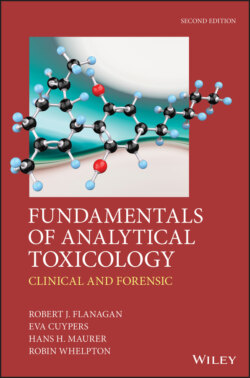Читать книгу Fundamentals of Analytical Toxicology - Robin Whelpton - Страница 13
Amount Concentration and Mass Concentration
ОглавлениеIn parts of Europe some laboratories report analytical toxicology data in ‘amount concentration’ using what have become known as SI molar units (μmol L–1, etc.), whilst others, especially in the US, continue to use mass concentration [so-called ‘traditional’ units (mg L–1, etc. or even mg dL–1)]. Most published analytical toxicology and pharmacokinetic data are presented in SI mass units per millilitre or per litre of the appropriate fluid [the preferred unit of volume is the litre (L)], or units that are numerically equivalent in the case of aqueous solutions:
When preparing written statements for a court of law or other purpose outside the normal reporting channels it is advisable to write out the whole unit of measurement in full (milligrams per litre, for example).
An exception to the above is carboxyhaemoglobin saturation (COHb), which is usually reported as a percentage of the total haemoglobin present in the sample (% COHb) – the SI convention is that fractions of one should be used rather than percentages, but this is generally ignored.
We have followed the recommendations of the UK NPIS/ACB (National Poisons Information Service/Association for Clinical Biochemistry and Laboratory Medicine) for reporting analytical toxicology results and have used the litre as the unit of volume and SI mass units except for lithium (and sometimes toxic metals/trace elements), methotrexate, and thyroxine (NPIS/ACB. Laboratory analyses for poisoned patients: Joint position paper. Ann Clin Biochem 2002; 39: 328–39). More information on SI is available (Flanagan RJ. SI units – Common sense not dogma is needed. Br J Clin Pharmacol 1995; 39: 589–94).
Conversion from mass concentration (ρ) to amount concentration (c) (‘molar units’) and vice versa is simple if the molar mass (M) of the compound of interest is known. Thus, if a solution contains 302.4 g L–1 of a compound of Mr 151.2 g mol–1
However, such conversions always carry a risk of error. Especial care is needed in choosing the correct Mr if the drug is supplied as a salt, hydrate, etc. This can cause great discrepancies especially if the contribution of the accompanying anion or cation is high. Most analytical measurements are reported in terms of the free acid or base, and not the salt.
